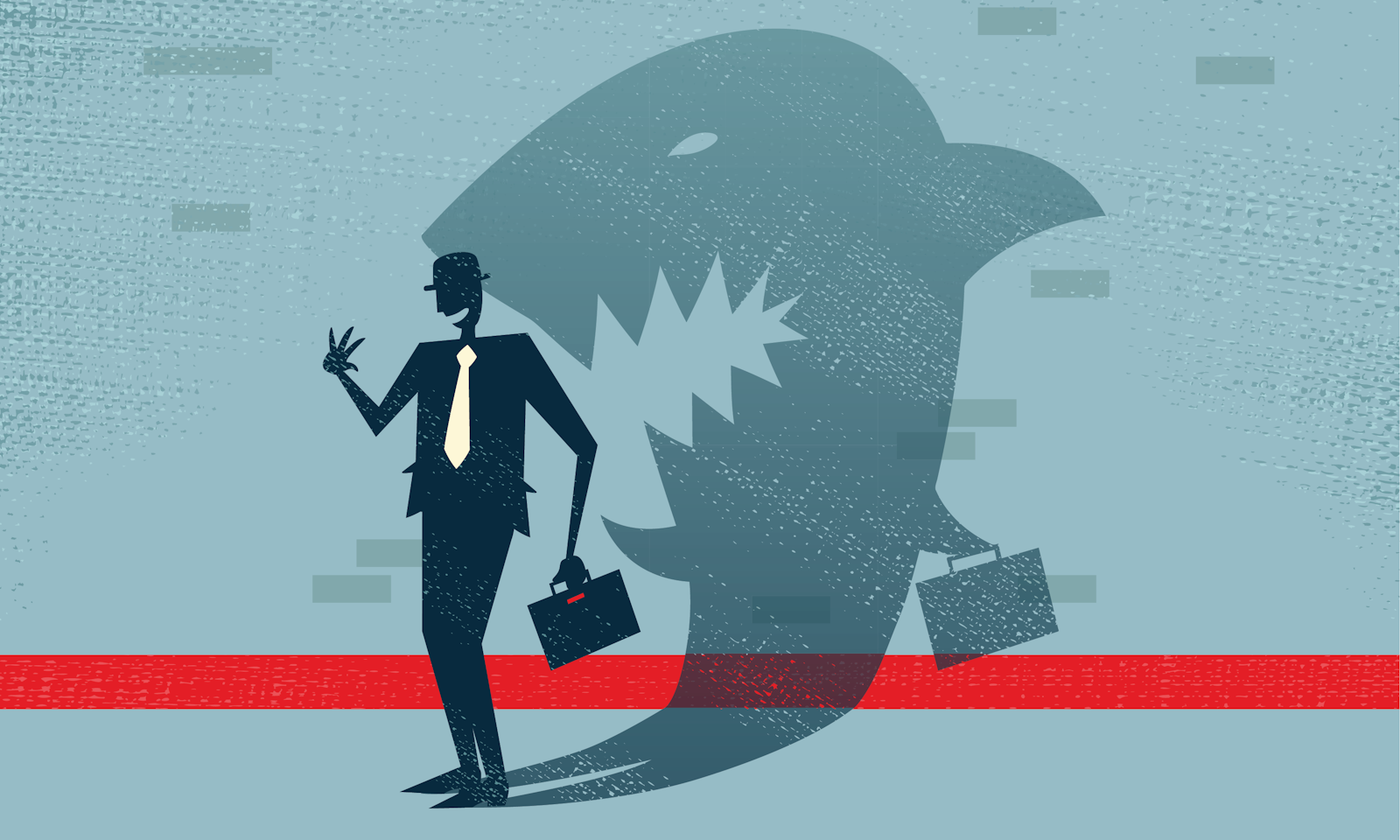This article originally appeared in Knowable Magazine.
Think of a psychopath and any number of Hollywood villains might come to mind, from charming killers like Hannibal Lecter to Anton Chigurh, portrayed with chilling menace by Javier Bardem in the film No Country for Old Men. But the traits and symptoms of psychopathy run along scales that range from weak to strong. So, someone may be mildly psychopathic or severely so. There could be a psychopath sitting next to you right now.
Some psychologists argue that the focus on violent and criminal psychopathic behavior has marginalized the study of what they call “successful psychopaths”—people who have psychopathic tendencies but who can stay out of trouble, and perhaps even benefit from these traits in some way. Researchers haven’t yet reached a consensus on which traits distinguish successful psychopaths from serial killers, but they are working to clarify what they say is a misunderstood branch of human behavior. Some even want to reclaim and rehabilitate the concept of psychopathy itself.
“Most of what people think about psychopaths is not what psychopathy actually is,” says Louise Wallace, a lecturer in forensic psychology at the University of Derby, in England. “It is not glamorous. It is not a spectacle.” Psychopathic traits exist in everyone to some degree and shouldn’t be glorified or stigmatized, she says.
Most psychopathic individuals just live around us.
In some ways, the study of successful psychopaths takes the field back to the beginning. In his 1941 book, The Mask of Sanity, the influential United States psychiatrist Hervey Cleckley set out the personality profile of a psychopath: a superficially charming but egocentric and untrustworthy person who conceals an antisocial core.
Cleckley (who later identified the notorious serial killer Ted Bundy as a psychopath) drew his insights from people he saw in psychiatric centers. Among his descriptions of psychopaths were people who could keep a lid on the worst of their behavior. He sketched the profile of a psychopathic businessman, for instance, who worked hard and appeared normal except for bouts of marital infidelity, callousness, wild drinking, and risk-taking.
Over the following decades, researchers who wanted to study psychopathy often did so in prisons. And so, fueled by lurid depictions in books and films, the psychopathic profile originally envisioned more broadly by Cleckley became tightly associated with dangerous and violent criminals in both the public and academic spheres.
That view is now being challenged. In the last 15 years or so, psychiatry has embraced what’s called a dimensional approach, based on the idea of scales and spectrums of trait and symptom severity. That replaced the categorical approach, which took a more binary view of mental syndromes and assessed whether conditions were present or not.
Seeing psychopathy through this different lens opened new doors to researchers. They no longer needed to work in prisons to study psychopathy. Instead, they could recruit groups from the general population, screen them for psychopathic traits and investigate the behavior and biology of “normal” people with successful or mild psychopathy. “Most psychopathic individuals just live around us,” says Désiré Palmen, a clinical psychology researcher at Avans University of Applied Sciences in the Netherlands.
Balanced by boldness
Psychopathy is a composite of several interacting traits. The traditional model of a psychopathic mind focuses on meanness and disinhibition. In psychological terms, meanness is aggressive resource-seeking without regard for others. Disinhibition shows itself as a lack of impulse control. People high in both traits feel little or no empathy and find it hard to control their actions, with often violent consequences.
As part of the recent rethink, psychologists have introduced a new factor: boldness, which they define as a mix of social dominance, emotional resiliency, and venturesomeness.
“You can think of boldness as fearlessness expressed in the realm of interactions with other people where you’re not intimidated easily, you’re more assertive, even dominant with other people,” says longtime psychopathy researcher Christopher Patrick, a clinical psychologist at Florida State University, who highlighted the role of boldness in a 2022 article on psychopathy in the Annual Review of Clinical Psychology.

A bold person is not necessarily a psychopath, of course. But add boldness to high degrees of meanness and disinhibition, Patrick says, and you could have a psychopath who’s more able to use their social confidence to mask the extremes of their behavior and so excel in leadership positions. In fact, it may be that the degree of boldness correlates closely with whether someone with traditionally psychopathic traits can make their life a success.
Other psychopathic traits can also benefit people in certain careers: Meanness, for example, often shows itself as a lack of empathy. “Within the corporate world, you want someone who can perform under pressure and make quick decisions, perhaps without displaying high levels of empathy, because they need to be able to make those cutthroat choices,” says Wallace.
A 2016 study of employees in an Australian advertising agency, for example, found that senior executives scored higher than more junior staff on measures of behaviors linked to psychopathic traits—such as being initially charming, poised, and calm, but also egocentric, remorseless, and lacking in self-blame.
Most of what people think about psychopaths is not what psychopathy actually is.
Other research has suggested that the language used to describe the ideal candidate in executive job ads could actively attract candidates with psychopathic traits. In one especially direct example, a firm in the United Kingdom advertised in 2016 for a “Psychopathic New Business Media Sales Executive Superstar! £50k—£110k.” The ad claimed that one in five CEOs was a psychopath and it wanted a candidate with their positive qualities.
Some have even suggested that psychopathic traits and associated tendencies such as fearlessness and narcissism can make people behave in a heroic way. A 2018 study, for example, suggested that first responders scored significantly higher than civilians on measures of psychopathy, including fearless dominance, boldness, and sensation-seeking.
The idea that some psychopathic traits could be positive does not sit well with everyone. “There has been a big, big fight about this,” says Klaus J. Templer, an organizational psychology consultant formerly of the Singapore University of Social Sciences.
Critics take issue with the inclusion of boldness as a defining psychopathic trait, Templer says. A 2021 study asked more than 1,000 students to agree or disagree with statements to probe traits including meanness (“I do not mind if someone I dislike gets hurt”), disinhibition (“I have taken money from someone’s purse or wallet without asking”), and boldness (“I’m a born leader”).
The results suggested that increased levels of meanness and disinhibition could explain the variance in self-reported antisocial behaviors, such as aggression, rule-breaking, and drug-taking. In other words, boldness was largely irrelevant.
But Patrick thinks some people don’t fit that interpretation. Other research has identified people who score higher than most on meanness or disinhibition, but who don’t seem to get into trouble for antisocial behavior. Boldness may make the difference: Some studies suggest that boldness can be protective in terms of well-being and workplace behavior.
“They would find it easier to kind of schmooze with people and use people and so forth,” Patrick says. This type of successful psychopath may turn out to be completely untrustworthy, but they initially come across as assertive and capable, he adds. “That’s what boldness brings to the table.”
The idea that some psychopathic traits could be positive does not sit well with everyone.
Much of this academic debate is a legacy of relying on the study of people who committed violent or criminal acts to assess and diagnose psychopathy, says Wallace. “Once you label psychopathy as a clinical disorder characterized by extreme violence, then all the positive adjustment traits get pushed to the side,” she says. “And now researchers are just kind of backtracking on themselves a little bit and saying, hang on, what about all these good things.”
Part of the problem, she says, is that researchers trying to study the positive traits of psychopathy don’t have their own version of the screening tool used to identify more severe cases. That’s a checklist focusing on the effects of disinhibition and meanness developed by the Canadian psychologist Robert Hare and immortalized in the 2011 book The Psychopath Test, by Jon Ronson.
To address that gap, Wallace has helped to produce a Successful Psychopathy Scale: a 54-question scale designed to identify and assess psychopathic traits in the general population. She hopes that the scale, currently under review at the Journal of Personality Assessment, will help researchers in the field assess, for example, the prevalence of successful psychopathy in the workplace, or psychopathic traits in people in positions of power and leadership. The scale asks responders whether they agree with statements such as “Gaining success can be tough; it is all about survival of the fittest.”
“I think the scale is needed, because at the moment successful psychopathy research is almost like fumbling in the dark,” she says. “The only way you can actually push research forward is by being able to measure these traits.”
Eventually, Wallace hopes the scale will help more people realize that a person with psychopathic traits is not always something to be afraid of. “There’s so much that we don’t know about individuals who are high on the prototypical psychopathic traits and how they just engage with their day-to-day lives,” she says. “And that’s because we’ve got lost in this idea of Hannibal Lecter.” ![]()
David Adam is an author and journalist in London.
This article originally appeared in Knowable Magazine, a nonprofit publication dedicated to making scientific knowledge accessible to all. Sign up for Knowable Magazine’s newsletter.
Lead image: jorgen mcleman / Shutterstock




























